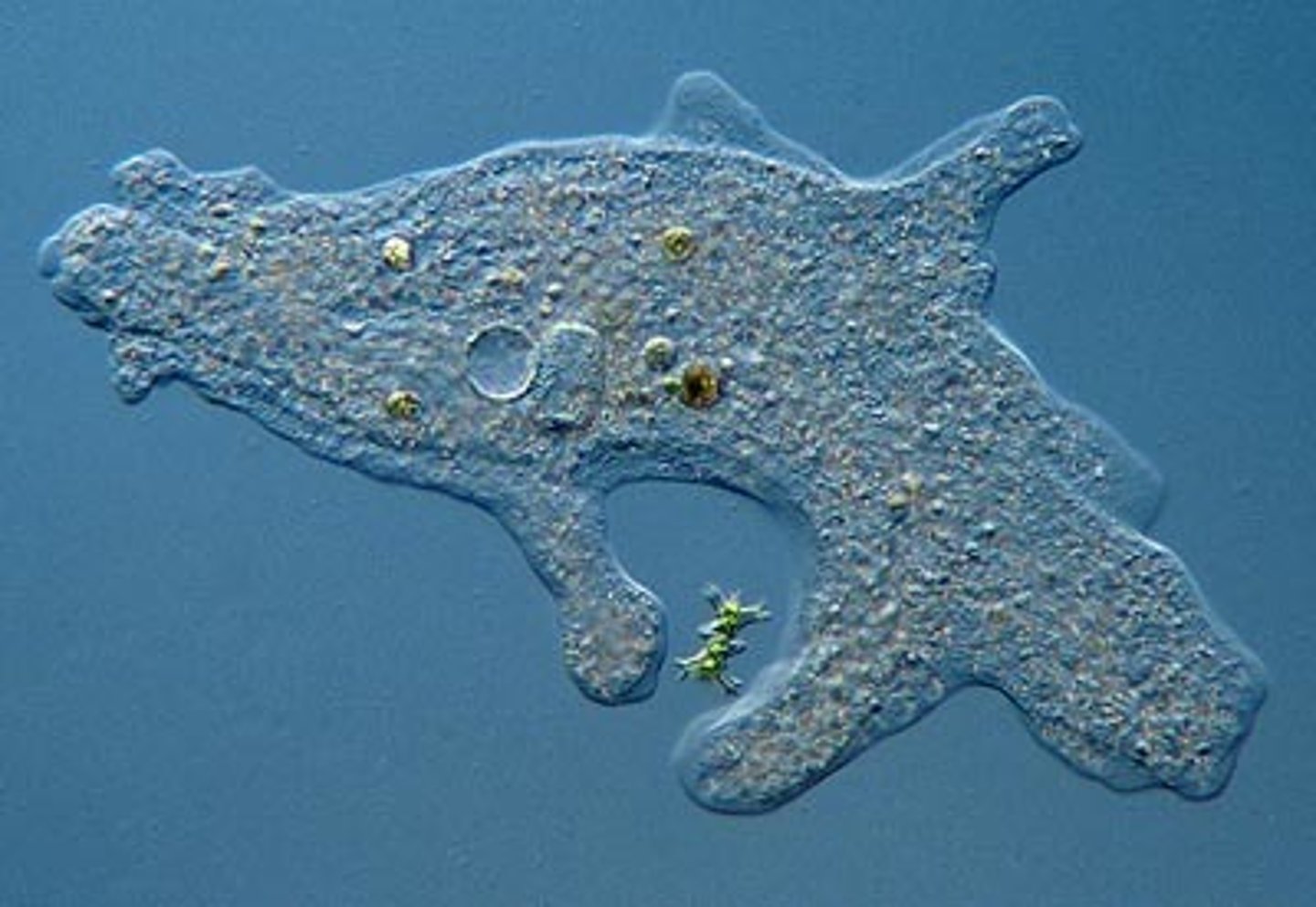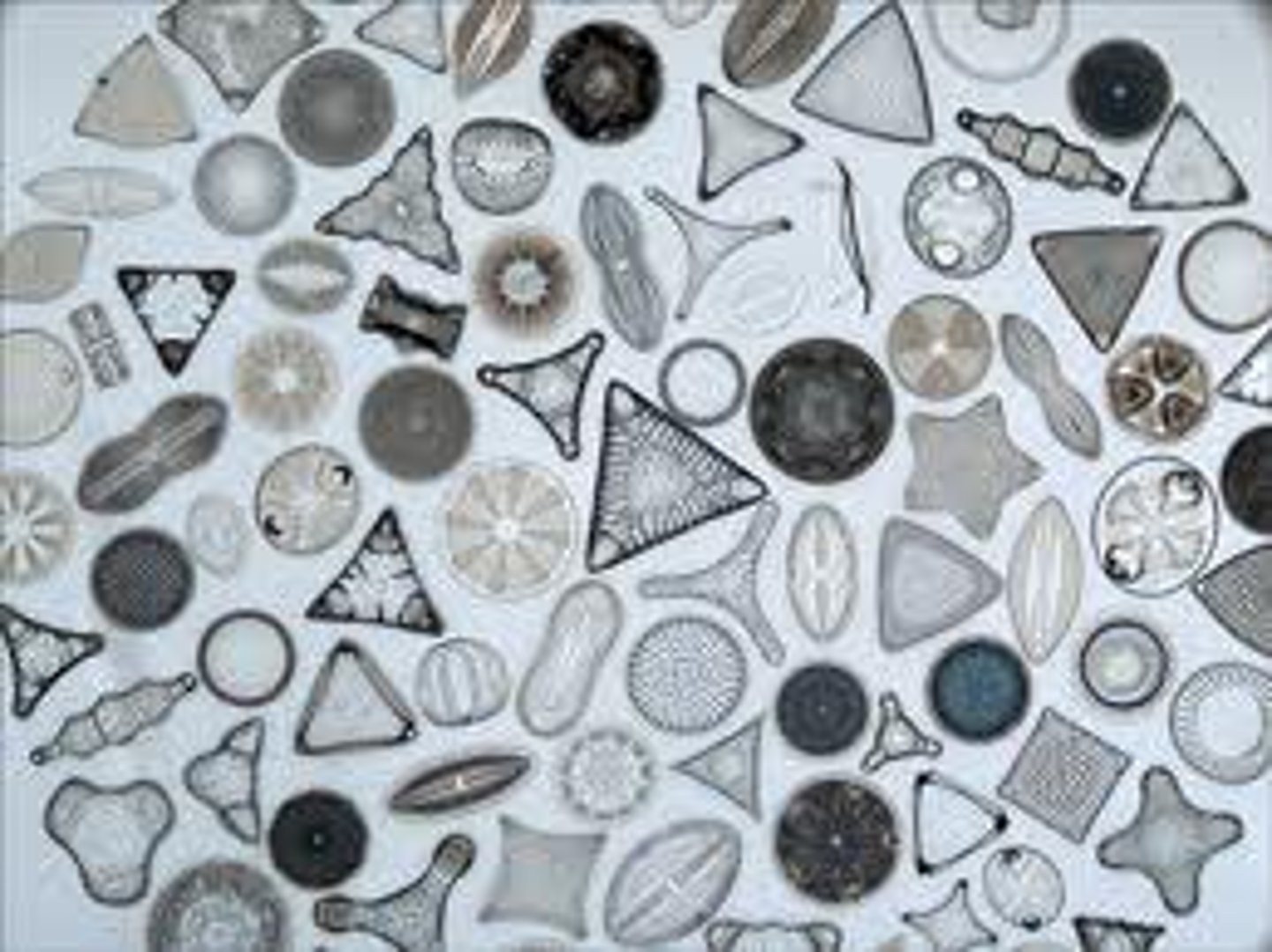Bio 2040 - Exam 3
1/75
There's no tags or description
Looks like no tags are added yet.
Name | Mastery | Learn | Test | Matching | Spaced |
|---|
No study sessions yet.
76 Terms
protozoa
Heterotrophic protists that ingest prey items or absorb small organic molecules
one-celled organisms that are more complex than bacteria
chitin
A tough, nitrogen-containing polysaccharide that forms the external skeleton of many insects and crustaceans and is found in the cell walls of fungi.
• Prevents phagocytosis
• Enables resistance of high osmotic pressure resulting from osmotrophy
Protists
A eukaryotic organism that cannot be classified as an animal, plant, or fungus.
were Earth's first eukaryotes
They are most abundant in moist habitats, and most of them are microscopic in size
Classified by Ecological Role Three major groups:
• Algae - generally photoautotrophic
• Protozoa - heterotrophic
• Fungus-like - resemble fungi in body form and absorptive nutrition
fungus-like protists
Heterotrophic protists that often resemble true fungi in having threadlike, filamentous bodies and absorbing nutrients from their environment.
phytoplankton
Microscopic photosynthetic protists that float in water or actively move through it.
**Euglena
flagellate
A protist that uses one or more flagella to move in water or cause water motions useful in feeding.
ciliate
A protist that moves by means of cilia, which are tiny hairlike extensions that occur on the outside of cells and have the same internal structure as flagella.
amoeba (amoebae)
A protist that moves by pseudopodia, which involves extending cytoplasm into filaments or lobes.

phagocytosis
A type of endocytosis that involves the formation of a membrane vesicle, called a phagosome or phagocytic vacuole, which engulfs a particle such as a bacterium.
endosymbiosis
A symbiotic relationship in which the smaller species (the symbiont or endosymbiont) lives inside the larger species (the host).
Euglenoids
possess unique, interlocking, ribbon-like protein strips just beneath their plasma membranes
Many are colorless and heterotrophic, but some possess green plastids and are photosynthetic
possess a light-sensing system, a red structure = eyespot/stigma
Plastids
are organelles in plant and algal cells that are distinguished by their synthetic abilities and that were acquired via endosymbiosis
**Resulted in massive horizontal gene transfer from the endosymbiont to the host nucleus
Plankton
swimming or floating protists, bacteria, viruses, and small animals
Excavata
Motility: Flaggela
Named for a feeding groove "excavated" into the cells
Asexual reproduction
by means of binary fission
• Related to some of Earth's earliest eukaryote
• Food particles are taken into cells by phagotrophy
Protein strips under plasma membrane allow crawling
• Some are heterotrophic, but Euglena is photosynthetic
Excavata: Kinetoplastids
Named for unusually large mass of D N A in a single large mitochondrion
Plants and Relatives
Supergroup that includes land plants also encompasses several algal phyla
• Kingdom Plantae (land plants) evolved from green algal ancestors
• Phylum Chlorophyta - green algae
• Phylum Rhodophyta - red algae
primary endosymbiosis
The process by which a eukaryotic host cell acquires prokaryotic endosymbionts.
Ingested cynobacteria
Endosymbiotic cyanobacteria
provided host cells with photosynthetic capacity and other useful biochemical pathways
Secondary plastids
derived from a photosynthetic eukaryote, likely a red alga
Originate from secondary endosymbiosis
• Eukaryotic host cell ingests and retains another type of eukaryotic cell that already has one or more primary plastids, such as a red or green alga
*Typically more than two envelopes
Alveolata
Named for saclike membranous vesicles present in cell periphery
Motility: flagella
Responsible for toxic blooms known as red tide
contains - parasitic organisms, predatory flagellates, and photosynthetic organisms.
Stramenopila
Motility: Strawlike flagellar hairs; secondary plastids derived from red algae
Asexual reproduction by means of binary fission (also sexual)
(diatoms) (brown algae) (fungus-like)

Rhizaria
Have thin, hairlike extensions of the cytoplasm called filose pseudopodia - derived from endosymbiotic green algae.
Thin star-like Cytoplasmic Extensions
Amoebozoa
Motility: pseudopodia.
Model organisms for understanding movement, cell communication, and development.
Slime Mold
Tertiary Endosymbiosis
The acquisition by eukaryotic protist host cells of plastids from cells that possess secondary plastids.
• About half of dinoflagellates are heterotrophic
• Other half possess photosynthetic plastids of diverse types that originated by secondary or even tertiary endosymbiosis
Choanoflagellate
Motility: Flagella
Feature distinctive collar surrounding flagella
Modern protists most related to the common ancestor of animals
secondary endosymbiosis
A process that occurs when a eukaryotic host cell acquires a eukaryotic endosymbiont having a primary plastid.
Such eukaryotic endosymbionts are often enclosed by the endoplasmic reticulum (ER), explaining why secondary plastids typically have envelopes consisting of more than two membranes.
phagotroph
An organism that specializes in phagotrophy (particle feeding) by means of phagocytosis as a mechanism of nutrition.
osmotroph
An organism that relies on osmotrophy (uptake of small organic molecules) as a mechanism of nutrition.
mixotroph
An organism that is able to use photoautotrophy as well as phagotrophy or osmotrophy to obtain organic nutrients.
extrusomes
spear-shaped projectiles to discourage consumers
toxins
Compounds that have adverse physiological effects in living organisms; often produced by various protist and plant species.
Bioluminescence
startles consumers
Slimy mucilage or cell walls
defend against herbivores and pathogens
cysts
thick, protective walls that remain dormant in bad conditions
Haploid Dominant Life Cycles
Most unicellular sexually reproducing protists
cells develop into gametes+ and − mating strains
Thick-walled diploid zygotes•
Survive like cysts
Diploid-Dominant Life Cycles
All cells except the gametes are diploid
Gametes produced by meiosis
Diatoms - one of few protists with this life cycle
• Asexual reproduction reduces the size of the daughter cells
• Sexual reproduction restores maximal size
supergroup Opisthokonta
Includes certain protists, Kingdom Animalia, and Kingdom Fungi
Swimming cells possess a single posterior flagellum
cyst/spore wall, or cell wall of filamentous growth and hyphae; the extracellular digestion of substrates with osmotrophic
- Fungi originated in aquatic habitats
ascomycetes
A phylum of fungi that produce sexual spores in saclike asci located at the surfaces of fruiting bodies known as ascocarps.
basidiomycetes
A phylum of fungi whose sexual spores are produced on the surfaces of club-shaped structures (basidia).
symbiotic associations with plants
absorptive nutrition
The process whereby an organism uses enzymes to digest organic materials and absorbs the resulting small food molecules into its cells.
FUNGI -secrete enzymes and absorb organic molecules
Fungi feed on diverse substrates
Store surplus food as glycogen
mycelium (plural, mycelia)
A fungal body composed of microscopic branched filaments known as hyphae.
hypha
A microscopic, branched filament of the body of a fungus.
aseptate
The condition of not being partitioned into smaller cells; usually refers to fungal cells.
septum
A cross wall; examples include the cross walls that divide the hyphae of most fungi into many small cells and the structure that separates the old and new chambers of a nautilus.
conidia
A type of asexual reproductive cell produced by many fungi (typically a spore at the end tip of a specialized hypha)
yeast
A unicellular fungus that may reproduce by budding.
dikaryotic
Mated hyphae whose cells each contain two nuclei.
Dikarya
A subkingdom of Fungi that includes the Ascomycetes and the Basidiomycetes.
plasmogamy
The fusion of the cytoplasm between two gametes.
karyogamy
The process of nuclear fusion when gametes unite.
Cryptomycota
earliest-diverging modern fungi
Aseptate hyphae
Early-diverging fungi
• Not partitioned into smaller cells
• Multinucleate
• Nuclei divide without cytokinesis
Septate hyphae
• Later-diverging fungi
• Septa - Cross walls dividing cells of mycelium
• Nuclear division followed by septum formation
Fungi Asexual Reproduction
Asexual reproduction is ideal for rapid spread
• No need to find a mate
• No fruiting body
• No meiosis
• Many fungi produce conidia
• Asexual spores grown at the tips of hyphae
Unicellular yeasts reproduce by budding
Asexual Fungi
• Often responsible for food spoilage, allergies, and disease
• Medically important fungi that reproduce primarily by asexual means include
• Athlete's foot fungus (Epidermophyton floccosum)
• Infectious yeast (Candida albicans)
Malarial parasite (Plasmodium)
• Alternates between humans and Anopheles mosquitoes
• Different stages in different hosts and host tissues
Ascomycota
Mostly terrestrial Decomposers; pathogens
many form lichen symbioses with eukaryotic algae or cyanobacteria
some are plant symbionts Asexual conidia
nonflagellate sexual spores in sacs on fruiting bodies
Basidiomycota
Terrestrial Decomposers
many are plant symbionts
Several types of asexual spores
non flagellate sexual spores on club-shaped on fruiting bodies
asci
Fungal sporangia shaped like sacs that produce and release sexual ascospores.
sporangia
a structure in certain plants and other organisms that is charged with making and storing spores
ascospore
The type of sexual spore produced by fungi in the phylum Ascomycota.
basidiospore
A sexual spore of fungi in the phylum Basidiomycota.
dimorphic fungi
Fungi that exist in two different morphological forms.
What characteristics are true of members of the Excavata like Euglena?
They have protein strips beneath the plasma membrane that facilitate flexibility for movement.
They inhabit wetlands.
They are photoautotrophs.
Useful in the study of the evolution of multicellularity in animals
Opisthokonta
Useful in the study of climate change
are known for filose pseudopodia, such as in radiolarians and foraminiferans.
Rhizaria
Major pathogen of potato crops
Stramenopila
Pathogen causing African sleeping sickness
Excavata
Alveolata
Responsible for toxic blooms known as red tide
are characterized by peripheral membrane sacs.
sporophyte
produces spores by meiosis
a phase in the alternation of generations life cycle.
The Plasmodium sporozoite
the first form of the malaria parasite entering the human body
Plasmodium life cycle.
The disease malaria from Plasmodium infections in humans.
Plasmodium uses mitosis to produce gametocytes.
Plasmodium gametes in the mosquito form a zygote after fertilization.
Human red blood cells are destroyed by the merozoite stage of Plasmodium.
A stage called a sporozoite produces in the human liver.
1. Invasion of the liver
2. Invasion of red blood cells
3. Formation of schizont
In ________ fungi, nuclear division results in a multinucleate condition.
aseptate
fungal mitosis
-septum follows division
-no cytokinesis
-ridged cell walls
animals and fungi both
exhibit heterotrophy and possess chitin.
coenocytic
Referring to a multinucleated condition resulting from the repeated division of nuclei without cytoplasmic division.